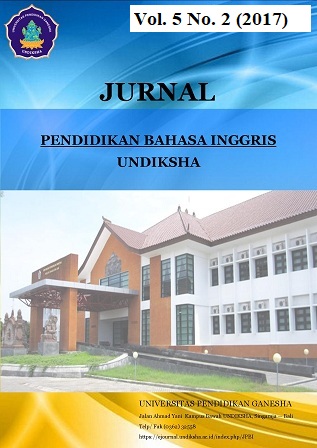DEVELOPING BILINGUAL STORYBOOKS AS SUPPLEMENTARY MATERIALS FOR TEACHING ENGLISH VOCABULARY FOR ELEMENTARY STUDENTS GRADE 4 AT SDN 6 BANYUNING
DOI:
https://doi.org/10.23887/jpbi.v5i2.12109Abstract
Penelitian ini bertujuan untuk (1) mengembangkan bilingual storybooks sebagai materi tambahan untuk mengajar kosa kata bahasa Inggris untuk kelas 4 SDN 6 Banyuning, dan (2) menganalisis kualitas dari pengembangan bilingual storybooks. Desain penelitian ini mengadaptasi dari model Dick dan Carey (2001). Prosedur yang digunakan adalah mengidentifikasi tujuan pembelajaran, menganalisis pembelajaran, menganalisis pelajar dan konteks, menulis tujuan kinerja, mengembangkan instrumen penilaian, mengembangkan desain produk, mengembangkan produk, melaksanakan penilaian formative dan merevisi produk. Subyek dari penelitian ini adalah siswa kelas 4 yang berjumlah 23 orang, yang terdiri dari 14 siswa laki-laki dan 9 siswa perempuan. Data dalam penelitian ini diperoleh melalui lembar observasi, panduan wawancara, kuisioner dan rubrik. Bilingual storybooks dikembangkan berdasarkan 5 tema, sehingga, terdapat 5 buah prototype produk di akhir penelitian ini. Bilingual storybooks dikembangkan dalam format small book (A5) dengan full-text translation. Validasi dari uji ahli menentukan bahwa pengembangan bilingual storybooks sebagai kategori yang baik. Sedangkan dari penilaian pengguna, buku dikategorikan sangat baik. Analisis dari kuisioner siswa menyatakan bahwa buku mudah untuk dibaca dan memotivasi mereka untuk belajar. Sehingga, bilingual storybooks cocok digunakan sebagai materi tambahan untuk mengajar kosa kata bahasa Inggris bagi siswa kelas IV di SDN 6 Banyuning.Kata Kunci : bilingual storybooks, mengajar kosa kata, pengajaran bahasa Inggris untuk anak-anak
This study aimed at (1) developing bilingual storybooks as supplementary materials for teaching English vocabulary for Grade 4 SDN 6 Banyuning, and (2) analyze the quality of bilingual storybooks developed. This research was R & D (research and development) which adapted from Dick and Carey model (2001). The procedures used namely, identifying instructional goals, conducting instructional analysis, analyzing learner and context, writing performance objective, developing assessment instrument, developing design product, developing the product, conducting formative evaluation and revise the product. The subject of this research was 23 students comprising 14 males and 9 females. The data of this research were obtained by using observation sheet, interview guide, questionnaire and rubric. There were 5 prototype products which were developed based on 5 themes in the end of this research. Bilingual storybooks were developed in the form of small book (A5) and presented with full-text translation. Expert judge’s validation found that developed bilingual storybooks were in a good category. Meanwhile, from the user judges, the books were categorized into very good category. The analysis of students questionnaire reveals that the books were easy to read and motivating to learn. Thus, the bilingual storybooks were proper to be used as supplementary materials for teaching vocabulary for fourth Grade students at SDN 6 Banyuning.
keyword : bilingual storybooks, teaching vocabulary, teaching English for young learners
Published
2017-10-24
Issue
Section
Articles
License
Authors who publish with the Jurnal Pendidikan Bahasa Inggris Undiksha agree to the following terms:- Authors retain copyright and grant the journal the right of first publication with the work simultaneously licensed under a Creative Commons Attribution License (CC BY-SA 4.0) that allows others to share the work with an acknowledgment of the work's authorship and initial publication in this journal
- Authors are able to enter into separate, additional contractual arrangements for the non-exclusive distribution of the journal's published version of the work (e.g., post it to an institutional repository or publish it in a book), with an acknowledgment of its initial publication in this journal.
- Authors are permitted and encouraged to post their work online (e.g., in institutional repositories or on their website) prior to and during the submission process, as it can lead to productive exchanges, as well as earlier and greater citation of published work. (See The Effect of Open Access)













